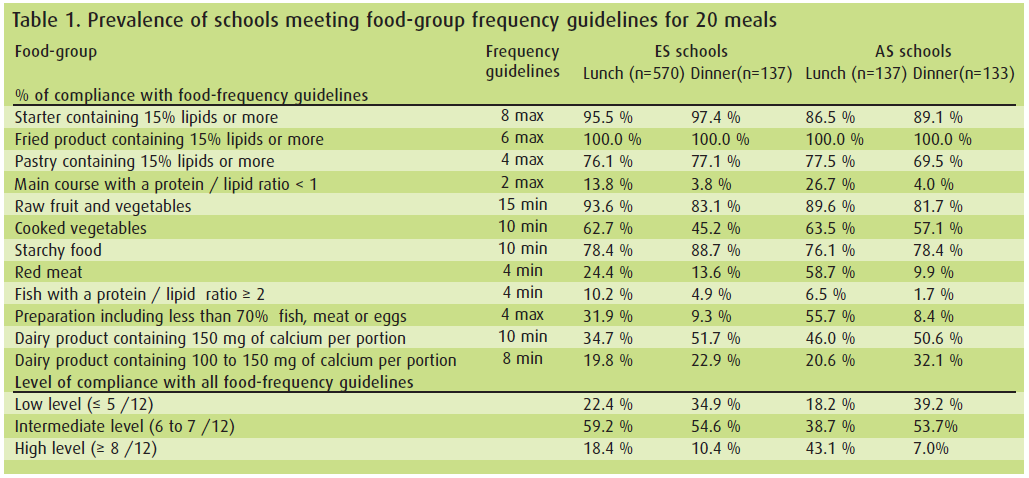School meals in French secondary state schools
School meals: a public health issue
Since the 1980s, overweight among French children aged 3-14 years old has increased and reached 14.5% in 2006-071. In parallel, more than 90% of French secondary state schools have a canteen, serving lunches to nearly 2,650,000 children and dinners to 159,000 boarders2, almost five days a week. Dietary balanced school meals must therefore be ensured to encourage schoolchildren to adopt healthier eating behaviours. Indeed, controlling the availability of food items in school premises is one way to lead children and adolescents towards healthier food choices at lunchtime3, 7 and may help to balance their energy intake7. In 2001, a circular addressing both the composition of school meals and food safety issues was introduced in France to improve the nutrient composition of school meals8 and appended the twelve food frequency guidelines*, published in 1999 to guarantee dietary balanced meals9. This study aimed at assessing the extent to which secondary state schools are familiar with and implement this circular, based on a nationally representative sample.
The first French national survey on school meals
In 2005, a cross-sectional survey was carried out on 1,440 lower and upper secondary state schools (i.e. 10-18 year-old children)10, 11. These schools came from two independent samples: an exhaustive sample of 240 upper secondary state schools providing agricultural training (AS) and a sample of 1,200 lower and upper secondary schools providing general and vocational teaching (ES), randomly selected among the 7,000 schools housing a cafeteria.
Every school received a questionnaire on its catering service and the implementation of the circular’s recommendations, and was requested to enclose all menus (lunches and dinners) served over one month. Every food item was allocated a nutrient composition according to the French national food composition database12, and was assigned to one or more of the twelve food groups defined by the guidelines, when meeting their specifications. The compliance of schools with regard to each food-group frequency guideline and to the overall twelve foodgroup guidelines was assessed. Three levels of compliance with these guidelines were defined: low (five or less out of twelve), intermediate (six or seven out of twelve) and high (eight or more out of twelve).
School meal composition needs to improve
Five hundred and seventy ES schools (48%) and 137 AS schools (57%) provided both questionnaire and menus for at least 15 consecutive days. The results confirmed that many French schoolchildren are enrolled to eat in secondary school canteens (94% in AS schools and 67% in ES schools). The twelve food-group frequency guidelines appended to the circular were known by almost 90% of the schools and were reported to be frequently used by 75% of them. However, menu analysis showed that progress is still required to achieve a meal composition in accordance with these guidelines (table 1). Some recommendations were followed by most of the schools, such as limiting high-fat products (starters, fried products and pastries) and providing plenty of raw fruit and vegetables, cooked vegetables and starchy foods. Other guidelines should be implemented further, especially in regard to the nutritional quality of main courses (red meat, meat-fish-or-egg-based dishes, main courses with a protein/lipid ratio <1, fishes) and dairy products which are met by less than a third and a half of schools respectively. Specific efforts are also necessary for evening meals to ensure that the nutritional requirements of boarders are covered. Indeed, evening meals had a much lower level of compliance with the recommendations aiming at improving the quality of the main dishes. Overall, less than 20% of secondary schools reached the high level of compliance to the guidelines, except the AS schools for lunches (48%). Moreover, the level of compliance shifted towards lower values for evening meals.
Meal characteristics (five courses) or some recommendations of the circular, such as the food purchasing manager being trained in nutrition (38% of schools) and the involvement of dietetic expertise when designing meals (6%), seemed to be linked to better dietary balance of meals. Implementation of the circular must therefore be promoted in schools, which may require stronger regulatory nutrition standards.

* The food-group frequency guidelines defined the minimum or maximum frequencies with which twelve food groups should be offered for twenty consecutive meals.
References
- Lioret S et al. Obesity (Silver Spring) 2009.
- Direction de l’évaluation, de la prospective et de la performance. Les établissements. In: Repères et référence statistiques sur les enseignements, la formation et la recherche. 2006.
- Jaime PC & Lock K. Prev Med 2009;48(1):45-53.
- Vereecken CA et al. Eur J Clin Nutr 2005;59(2):271-7.
- Food Standard Agency. School meals in secondary schools in England. 2004. Report No.: Research Report RR557.
- Cullen KW, et al. Public Health Nutr 2006;9(6):814-20.
- Briefel RR et al. J Am Diet Assoc 2009;109(2 Suppl):S91-107.
- Circulaire n°2001-118 du 25 juin 2001. Composition des repas servis en restauration scolaire et sécurité des aliments. In: Bulletin officiel du ministère de l’Education nationale et du ministère de la Recherche; 2001.
- Groupe permanent d’étude des marchés de denrées alimentaires. Recommandations du groupe permanent d’étude des marchés de denrées alimentaires (GPEM/DA) relatives à la nutrition. In: JO de la direction des Affaires juridiques du ministère de l’Economie, des finances et de l’industrie; 1999.
- Dubuisson C et al. Br J Nutr 2009;102:293-301.
- Afssa. Evaluation de la connaissance et de l’application de la circulaire du 25 juin 2001 relative à la composition des repas servis et à la sécurité des aliments dans les établissements publics du second degré (2005-2006); Rapport Afssa, 2007.
- Favier J-C et al. Répertoire général des aliments – Table de composition. 2ème ed. Paris: Lavoisier; 1995.
